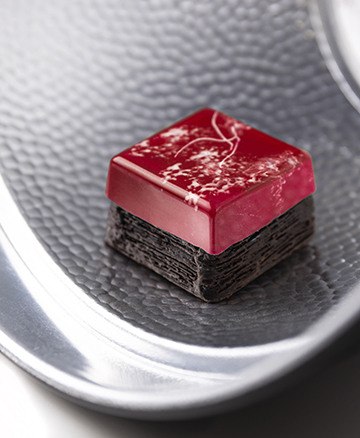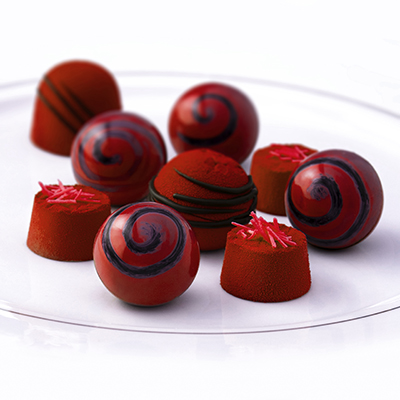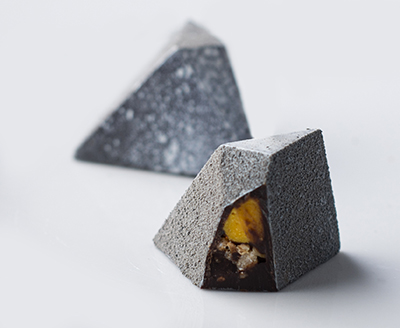Chocolate Artistry by Luis Amado
The world of creating fine desserts is truly unique, as it employs such a variety of skill and mastery to create even the smallest treats. The utilization of chemical knowledge, generally assumed to be reserved for a lab, creates new textures, structures, and designs through the manipulation of basic ingredients using sophisticated techniques. Culinary maturity, both savory and sweet, allows for the development of bold and distinct flavors. And the sheer artistry required to sculpt and paint unconventional materials is something to be admired. It is especially true for the artisan world of chocolate which requires precision and artistry in order to create silky, luring, and attractive delicacies for people to admire and enjoy.

We are honored to have spoken with Luis Amado, an internationally renowned chef, and a master chocolatier. His chocolate creations are works of art, and truly stand out in the pastry world. In our interview, he also shared his valuable experience and advice for aspiring young cooks. We hope you enjoy reading his personal journey of how he climbed to the top of the culinary world to become a master chocolatier.
Q: You grew up in Mexico and later moved to the US. Please share with us how you became the ″chocolate master″, your training, and your experiences.
A: Since I was a teenager I knew deep in my heart that I enjoyed cooking and making desserts. I grew up helping my grandmother′s cooking and always enjoyed watching TV cooking shows. Then, when I turned 18 years old, I decided to come to the USA and attend culinary school and eventually obtained my associate degree in culinary arts. My parents helped me with the expenses, it was not easy at all as they had to make many sacrifices in order to pay tuition. As a student, I was always the first one in class and the last one to leave the cooking labs. While being a culinary student, I was fortunate to be selected to represent Grand Rapids Community College in various local and national cooking competitions. I became fascinated with the intensity of the training schedule and the number of additional techniques and experience that cooking competitions would give to a student at a young age. I then graduated with honors and instead of going back to Mexico, I was offered a job as an executive chef at the age of 24 years old. Prior to becoming an Executive Chef, I worked as a dishwasher, line cook, pantry cook, and chef′s assistant. I continued my school preparation and went on to get a bachelor′s degree in general education. Two years after graduating from culinary school, I competed in the International Culinary Olympics held in Berlin. I became addicted to cooking competitions and almost every year I was able to enter more and more competitions while still having jobs as an executive chef.
In 1998, I decided to leave the hectic part of the kitchen industry and took a huge pay cut to start a job as a teacher in what is now called the Culinary Institute of Michigan in Muskegon MI. I worked there for 22 years and eventually became the program director for the baking and pastry program. While working as an educator, I found my love for chocolate, continued winning many chocolate shows and eventually started teaching chocolate classes to students while traveling to different countries each year to learn more about chocolate.

Q: Each of your chocolate creations looks like a piece of fine art. What is your inspiration? Where can people buy your chocolate?
A: I don′t necessarily have one specific source of inspiration. Every day I look at art such as drawings, paintings, sculptures and I often meditate and try to see new ideas. I love innovating and am not afraid to try different things. I loved my technical drawing classes while in high school. I always have notebooks all around my house and I am often drawing new ideas but to better answer your questions my inspiration mainly comes from my imagination. I do not sell chocolate. I only train chocolatiers from all over the world in the art of making chocolate with my personal approach. I am passionate about teaching and I believe I have much experience in that. I am not interested in selling, there is nothing more satisfying for me than teaching.
Q: When preparing chocolate pieces, what are the important tips you would like to share and your criteria for the taste, appearance, and texture?
A: You have to use the absolute best ingredients you can have. If you start a recipe with garbage you end up with garbage. I only work with couverture. Couverture is the official name for ″true chocolate″ that is chocolate made with a larger percentage of cocoa butter and no hydrogenated oils or wax as found in many products. In regards to appearance, I pay attention to the presentation. I love to see clean lines with fine decor. I like to see a chocolate shine when it needs to shine and not shine when it has a matte finish. I love natural dark brown colors more than vibrant colors but my followers also like my color techniques and therefore I tried to do what makes them happy and not just focus on my preferred styles, but the presentation is unique and important. I am not as picky as people may think. I do hate to see fingerprints in chocolate or chocolate that has not been tempered properly. Texture, on the other hand, is very important and comes from good tempering, handling, and storing of the chocolate. Successful chocolatiers always consider this while producing their work.
Q: Chocolate provides many benefits to people′s health. What ingredients do you generally use to ensure the health benefits and what ingredients would you stay away from?
A: I love to keep all my ingredients as natural as possible. That is no artificial color and I only use natural cocoa butter when possible. Perhaps limiting the amount of sugar in chocolate and replacing it with honey. I will definitely stay away from shortening, modified wax, and most processed ingredients.

Q: Please share with us some of your memorable experiences when making chocolate.
A: It is almost a daily ritual. I often get asked to design chocolates for large scale productions or for very special occasions. Every occasion is memorable. I take the same amount of pride when making chocolates to share with my neighbors as when I am making them for international competition or for a middle eastern king. Making chocolate bonbons three hours prior to a competition and still winning best of the show is one of my most memorable experiences. In 2007, while prepping for a chocolate competition, I had to make 24 individual chocolate truffles in a very special shape. I, unfortunately, had an accident with the knife, went to the ER at 4:00 AM, came back to the kitchen, and did my chocolate which normally would have taken me six hours in less than one hour but still won best of the show in a national chocolate competition. I will never forget.
Q: Your culinary experiences are very impressive. For example, you have been a judge in National and International Culinary Competitions. What is your approach to being a judge in culinary competitions? What do you look for in the contestants′dishes?
A: I look for a sense of urgency, determination, the food is secondary to me. I looked for sanitation skills but I tried to understand the competitors′ intentions and how well she or he may have responded to the demands. I am very personal and I try to offer very constructive advice.
I look for originality when appropriate. If they presented a classical dish and do not prepare it as it should, then I critique them for that because while we need to innovate I believe we have to maintain the originality in classical dishes.
Q: You have been giving master classes worldwide. Please share with us your findings as to how people′s tastes vary among different cultures in terms of chocolate.
A: For the most part I have come to the conclusion that most people appreciate dark chocolate in Europe more than in the USA. The US loves sugary things and of course milk chocolate. Argentina loves caramel and white chocolate. Unfortunately, the United States does not appreciate true, good chocolate or at least not more than they do chocolate coatings or chocolate with artificial flavors. I truly believe that people in Europe and some Latin countries have a better understanding of chocolate or at least grew up eating so much that they will not settle for anything less.

Q: You are building a world-class chocolate academy. Please tell us more about this academy.
A: I teach private classes for up to four people. My classes are semi-private. Students learn most of my modern techniques and also because it is a private class, I can focus on any area they want to excel. The classes are held in my personal studio which is actually in the lower section of my residence. I have everything in regards to equipment and technology to offer a great learning experience. Lunch is provided by us. They get a certificate of attendance, apron, a workbook with detailed recipes and sketches of my chocolates, as well as access to an online data of videos. I love to teach. I love to connect and transmit my passion for chocolate to others. Students have the option to let me know if they want a private class entirely customized for them and I would be happy to send them a quote. Otherwise, my classes are at the most scheduled for only four students.
Topics that I Teach:
- Bonbon exterior design including at least 10 decorating techniques
- Large quantity molding and profitable business chocolate production
- Design and building of chocolate interiors with various layering techniques that I am known for
- Controlling shelf life
- Ganache formulation using fats other than butter when making ganaches
- Cost control and formula development
- Running a successful chocolate business from home
- Caramel and liquid center production
Q: As a successful chef in many areas, what is your advice to aspiring young cooks?
A: Time is money. Do not get into this field unless you are willing to work hard and enjoy what you are doing. It is not just about cooking, this career is very stressful, hot kitchens, people screaming at you, and accidents happen often. Long hours; when the rest of the world is having fun, you are cooking for them. Invest in a very comfortable bed; when you go home you better rest very well. I would also say, give everything your very best. Learn from your mistakes, always work with great ingredients, show up to work on time. Maintain a clean uniform all the time. Do not clean your hands on the apron, do not smoke. Never stop learning, ask your boss to send you to continuing education classes every year. Read , read, read the network and treat others as you like to be treated.

Q: Do you have any activities in the near future that you wish to share with our readers?
A: I will be posting an article in So Good Magazine # 24, a world-known magazine for chefs that comes twice a year. You can learn more about it by going to www.sogoodmagazine.com. Also, I will have a chocolate course available online starting in September.
We are thankful for Mr. Amado′s candid answers to help us to understand his profession and how hard he has worked to get to the top of his career. His personal experience is inspiring and sheds light on the competitiveness and high requirements of the culinary world.
Mr. Amado′s Instagram